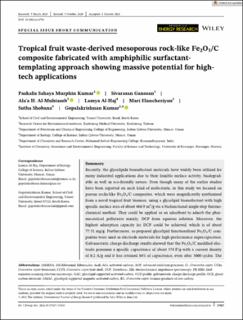Tropical fruit waste-derived mesoporous rock-like Fe2O3/Ccomposite fabricated with amphiphilic surfactant-templating approach showing massive potential for high-tech applications
Kumar, Paskalis Sahaya Murphin; Ganesan, Sivarasan; Al-Muhtaseb, Ala'a H.; Al-Haj, Lamya; Elancheziyan, Mari; Shobana, Sutha; Kumar, Gopalakrishnan
Peer reviewed, Journal article
Published version
Permanent lenke
https://hdl.handle.net/11250/2977138Utgivelsesdato
2021-05Metadata
Vis full innførselSamlinger
Originalversjon
Kumar, P.S.M., Ganesan, S., Al-Muhtaseb, A. Tropical fruit waste-derived mesoporous rock-like Fe2O3/Ccomposite fabricated with amphiphilic surfactant-templating approach showing massive potential for high-tech applications. International Journal of Energy Research, 45(12), 17417-17430. 10.1002/er.6798Sammendrag
Recently, the glycolipids biosurfactant materials have widely been utilized for many industrial applications due to their feasible surface activity, biodegradable as well as eco-friendly nature. Even though many of the earlier studies have been reported on such kind of surfactants, in this study we focused on porous rocks-like Fe2O3/C composites, which were magnificently synthesized from a novel tropical fruit biomass, using a glycolipid biosurfactant with high specific surface area of about 466.9 m2/g via a biofunctional single-step thermochemical method. They could be applied as an adsorbent to adsorb the pharmaceutical pollutants mainly, DCF from aqueous solution. Moreover, the highest adsorption capacity for DCF could be achieved, which is of about 77.51 mg/g. Furthermore, as-prepared glycolipid functionalized Fe2O3/C composites were used as electrode materials for high-performance supercapacitors. Galvanostatic charge-discharge results showed that the Fe2O3/C modified electrode possesses a specific capacitance of about 374 F/g with a current density of 0.2 A/g and it has retained 84% of capacitance, even after 3000 cycles. The remarkable performances are mainly due to the surface amendments of the Fe2O3/C composite, using biologically produced glycolipid surfactant, would have more favorable foreground towards the upcoming energy crises.

